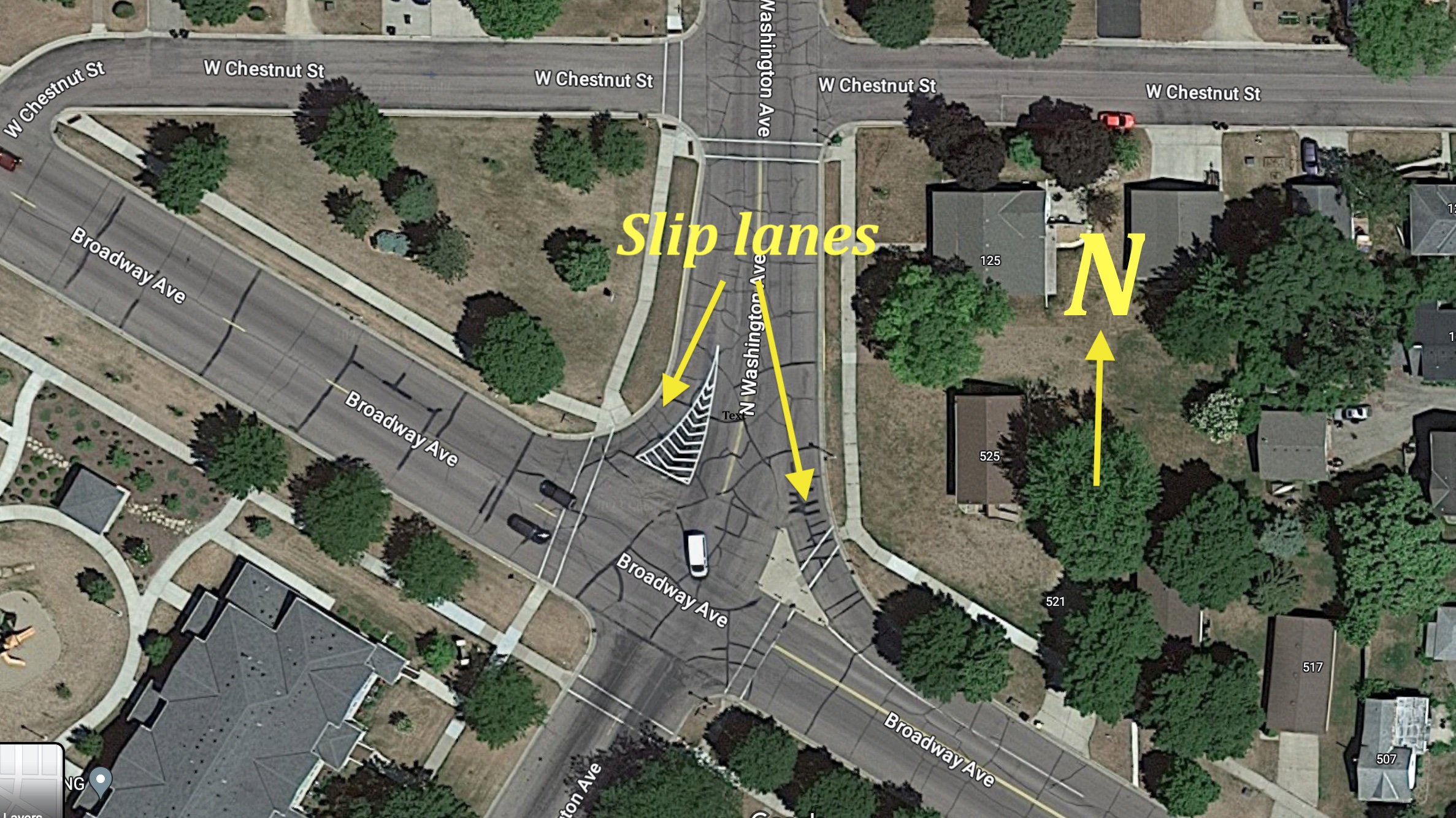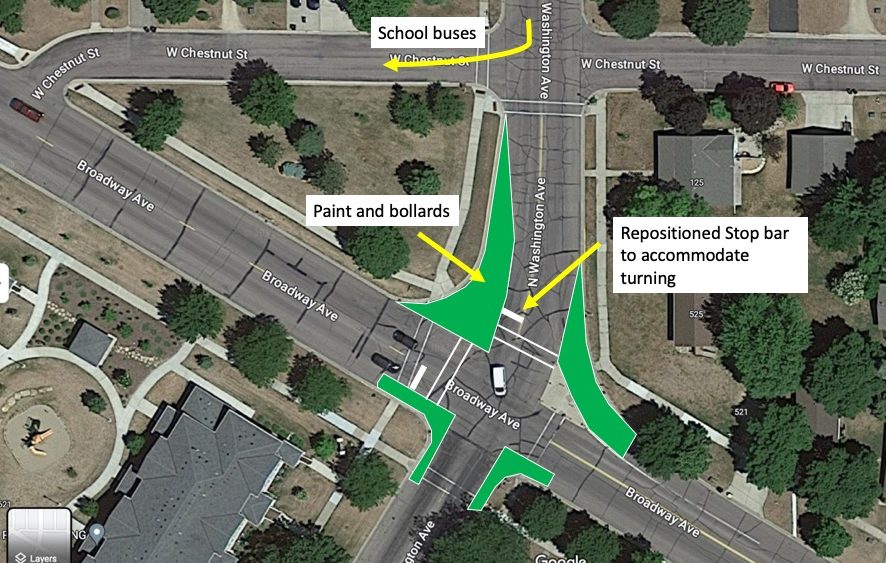 Fixing the Broadway and Washington Intersection
Fixing the Broadway and Washington Intersection
The City of St. Peter will soon embark on an Intersection Control Evaluation (ICE) of the four-way stop at Broadway and Washington. This is one of the busiest intersections in St. Peter at more than 8k-9k vehicles entries per day. It is the busiest four-way stop in St. Peter for certain. It is a crossroads of our city used to connect to key destinations such as the community center and library; schools; churches; parks; downtown; and Highway 169. Most people experience the intersection as drivers, but there are others who walk it and bike it, and their safety and comfort need to be considered as well.
The ICE is intended to assess whether the intersection is safe and functioning as designed. If the finding is that it is not, then changes will be proposed. Previously, an ICE was conducted at Broadway and Sunrise, and a roundabout was proposed as a remedy for the identified safety and projected congestion issues there. A roundabout seems to be the direction we are heading with this ICE, but that doesn’t need to be a foregone conclusion. There are other remedies that are arguably as effective, and are unambiguously less expensive and quicker to implement.
Before continuing, I feel it necessary to state that I am not opposed to roundabouts. I think the one at the high school works brilliantly. But roundabouts are not one-size-fits-all solutions and due to their large footprint, disruptive construction schedule, and high cost; they should only be implemented judiciously and where they are the best/only effective traffic control option. A roundabout can be several million dollars; everything I mention below can be quickly implemented for several thousand dollars.
Let’s talk about the intersection in its current form. It can be busy and, like most major streets in St. Peter, it is wider than it needs to be. Its other safety issue is the presence of slip lanes. These exist on the NE and NW corners to facilitate large vehicles and reduce driver delay for turning on/off N Washington. (For the record: there’s nothing wrong with having a little driver delay.) Bus drivers moving between North and the Middle School like slip lanes. Walkers and bikers hate slip lanes because drivers don’t slow down, and they are usually looking away from the person trying to cross the street. Plus, they create an additional leg of the intersection for people to cross. More exposure = more danger for walkers.
 So the question is: Can we eliminate the slip lanes and still accommodate the turning movements of larger vehicles? Yes, and here is how:
So the question is: Can we eliminate the slip lanes and still accommodate the turning movements of larger vehicles? Yes, and here is how:
- The NE slip lane can be closed if the STOP bar for southbound Washington is moved back a few feet. Doing that will allow large vehicles to encroach into the oncoming lane to complete their turns. This strategy is often used in large cities on bus and trucking routes.
- The NW slip lane can be closed and school buses can be directed onto Chestnut Street. Chestnut would remain one-way eastbound, but signage would be posted to allow special dispensation to school buses at certain times of day, during the school year. For good measure, the STOP bar for eastbound drivers on Broadway could also be moved back.
The next safety problem is the large footprint of the intersection. Because this creates different challenges for drivers and walkers, their challenges and solutions will be discussed separately. Let’s talk about drivers first. N Washington joins the street grid of older St. Peter at this intersection, and as a result southbound vehicles must adjust their vector. But the real problem is the massive amount of pavement for an intersection of two 2-lane streets. Who goes where and does what is a bit ambiguous at this intersection. Oddly enough, the crash count here isn’t bad: there were 13 crashes in 8.5 years, 2 of which were injury crashes. Norms, eye contact, and a measure of caution due to uncertainty govern vehicle movements at this intersection, and those ingredients seem to be a recipe for relative safety. But I would still urge the City to install a red flashing beacon atop the STOP sign for southbound Washington drivers. (Something like this can be found on Jefferson and 7th Street for eastbound drivers.) The lack of any other traffic control devices on Washington between Dodd and Broadway can certainly set the wrong expectation for a driver unfamiliar with the area. But that’s a problem for a different discussion.
The user group most challenged by the large footprint of the current intersection are walkers and bicyclists. Remember that this is a crossroad of the community for many destinations that serve youth. Kids don’t drive. Also, there is an affordable housing development on the SW corner of the intersection. The bottom line is that we need to expect and design for walkers and bicyclists at this location.
The longer a person spends crossing the street, the more likely it is that they will be hit by a vehicle. For this reason, crossing distances matter, and just narrowing an intersection by a few feet can make a big difference. The crossing distance varies between 65 and 75 feet at this intersection. For reference, Highway 169 at Swift Street is 65 feet curb-to-curb. For additional reference, walkers can move at 2-4 feet/second. Think about how long it will take for someone of impaired mobility to cross such a distance. This intersection is way too wide.
Large crossing distances also mean more time spent on the corner waiting for all four drivers to stop so a walker can cross. What I said before about the uncertainty, eye contact, and negotiation amongst drivers making for a safer intersection – yeah, that doesn’t work for soft and small humans. Claiming your right of way by placing your 3 ton SUV in the path of another vehicle is not an option. The only way to fix this problem is by narrowing the intersection.
 Whatever the ICE concludes about the safety and functioning of the current intersection, the choice shouldn’t have to come down to roundabout or no roundabout. The practice of transportation planning and engineering is evolving to the point where we no longer simply study an intersection and implement major changes. We have now introduced an intermediate step, where we do experimentation and observation to see if less invasive, and less costly solutions can succeed. Demonstration projects as these are called are recognized and frequently deployed by MnDOT to improve safety, calm traffic, and improve connectivity for walking and biking. Demonstration projects may be applied to intersections and corridors. Perhaps best of all, the Statewide Health Improvement Partnership has funding to support such demonstration projects.
Whatever the ICE concludes about the safety and functioning of the current intersection, the choice shouldn’t have to come down to roundabout or no roundabout. The practice of transportation planning and engineering is evolving to the point where we no longer simply study an intersection and implement major changes. We have now introduced an intermediate step, where we do experimentation and observation to see if less invasive, and less costly solutions can succeed. Demonstration projects as these are called are recognized and frequently deployed by MnDOT to improve safety, calm traffic, and improve connectivity for walking and biking. Demonstration projects may be applied to intersections and corridors. Perhaps best of all, the Statewide Health Improvement Partnership has funding to support such demonstration projects.